#matzoh meal
Explore tagged Tumblr posts
Text
Quick Bread - Moist Passover Bagel

Who said a sandwich is off limits during Passover? These fluffy, moist bagels are made with eggs and matzoh meal; yeast is not required.
1 note
·
View note
Photo

Moist Passover Bagel Recipe Who said a sandwich is off limits during Passover? These fluffy, moist bagels are made with eggs and matzoh meal; yeast is not required.
0 notes
Photo

Jewish Chicken Soup This traditional Jewish chicken soup with matzoh balls is hearty, soothing, and delicious. Perfect for anyone feeling under the weather.
0 notes
Text
matzoh pizza is OUT matzoh quesadillas are IN
#i love easy pesach meals#i am but a tired college student as much as i love the briskets and matzoh ball soups i have neither the time nor energy unfortunately#pesach#jumblr
40 notes
·
View notes
Text

late entry... apple lemon salad, challah and apples with honey, and matzoh ball soup
september 15th, 2023
12 notes
·
View notes
Text
The two big things of Passover: matzoh brei an matzoh meal pancakes! I just made a batch the other day.
Here's another tip: If you have the freezer space, you can make the pancakes and freeze them. You can freeze matzoh brei too.
With five of us in the house, my mother would spend one day turning 5 lbs of matzoh into matzoh brei, and another day turning three or four dozen eggs into matzoh meal pancakes. She'd wrap them up and freeze them, and whenever we wanted some (even lasting after Passover), we could just take out what we wanted, put it in the oven, and have it nice and hot like it just came from the frying pan.
I took over doing it when she was no longer doing it.
In college, I provided matzoh meal pancakes for homesick fellow Jews, and got some non-Jewish friends hooked on them.
I see your carefully curated Instagram brunch with chia seed pudding, avocado toast, and kombucha and raise you this: Chremslach.
Chremslach (‘chremsl’ for singular) are better known as matzah meal pancakes or even bubbaleh and are a lesser-known delicacy of Ashkenazi cuisine. You can find cousins throughout the Jewish culinary world. Sephardic Jews, for example, might be more familiar with bimuelos (Ladino for ‘dumplings’), a Hanukkah or Passover treat also made with matzah meal batter.
Chremslach rarely enter the conversation when it comes to figuring out what to do with extra matzah meal after Passover. But there’s nothing about chremslach that makes them extra palatable while recounting the Exodus. In fact, they’re better than your typical batch of pancakes. Chremslach are what you actually want when you’re craving pancakes for breakfast.
There’s more substance than a typical, white-flour pancake. Chremslach are hearty yet moist, fluffy, and tasty on their own in a way your average pancake just is not. The latter relies heavily on what you put on top of it, but chremslach can survive on their own. They’re nutty, but not too sweet. What you put on top (fresh fruit, honey, cinnamon) are just complementary, but not necessary.
Notes:
The batter should look chunky and have an obvious matzah meal smell both before you put it on the pan and once you serve them.
I use a ¼ cup of batter at a time, but you can use as much or as little as you like. Just be sure to keep an eye on the butter or olive oil in the pan. The chremslach will quickly absorb any liquid in the pan, so you’ll need to add more throughout to avoid burning.
Store extra batter in a container in your refrigerator and use it within a week.
184 notes
·
View notes
Text
for the foodies.. i have never made many jewish foods myself and i dont have family around to help me make them. recently i have tried to make potato kugel a couple times but every time it comes out it is... moist..... i have soaked the potatoes, let them drain, pressed them, everything that was recommended in the recipes ive used and it still seems to have too much moisture at the end. ive seem people recommend adding matzoh meal or oats but i havent tried that because i didnt want to change the simple recipes i was using.. at first i thought maybe i didnt grate the potatoes enough but the last times i did as much as i could and it was better but still too moist.. any advice or tips? ive mostly only cooked non jewish meals i struggled with latkes last year too potatoes are my enemy :'( !תודה לכולם
10 notes
·
View notes
Note
Headcanon request for The Boys' favorite foods/meals?
The Boys' Favorite Foods/Meals ☻
Annie January (Starlight)

Steak de Burgo. It's a beef tenderloin either topped with or marinated in butter, garlic, and herbs, and is an intrinsically Iowan meal that started in her hometown, Des Moines, and reminds her of all the best things about home. She has really fond memories of going to the Dallas County Fair with her friends and mother and enjoying some with some Coca-Cola. The meal made everything feel OK and normal, and continues to do so for her now.
Billy Butcher
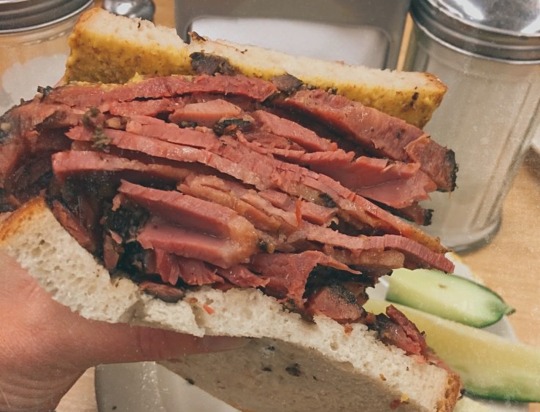
Pastrami sandwiches. Growing up halfway down from a kosher deli in the heavily Jewish community of London's East End, he and Lenny would often find comfort in spending late hours there eating sandwiches and matzoh ball soup when their father was in his worst moments. Still, he's mostly distanced himself from the memories that come with the dish; the guy just really likes pastrami sandwiches, and will devour even the biggest, meatiest thing of it in one minute tops. It's slightly concerning and always ends in acid reflux.
Frenchie
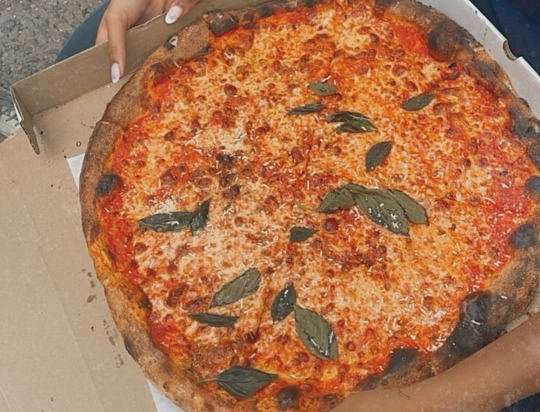
New York style pizza, specifically with marina, mozzarella, and basil. Unlike most of The Boys, Frenchie doesn't have many memories attached to it, but that's what he likes about it — it's entirely separate from his past life (to this day, the guy can't eat pelmeni because it reminds him of Little Nina). He knows all the best spots in town, and actually has several Yelp accounts dedicated to rating pizza. He has several because his usage of colorful language has gotten him banned.
Hughie Campbell
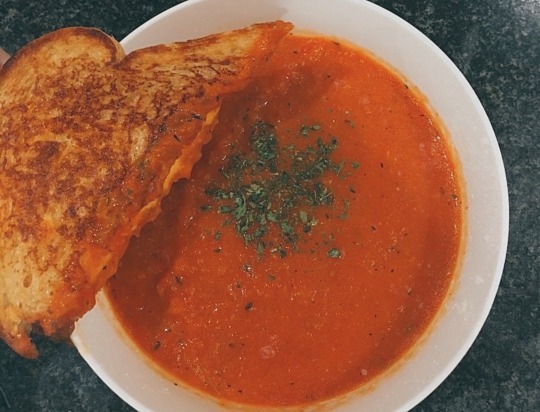
Grilled cheese and tomato soup. He's been eating it ever since he was a kid; it started with his mom making it, then his dad, and then him, so it's a huge comfort dish for him. While his go-to answer would, of course, be grilled cheese and tomato soup, Hughie also has a guilty pleasure for grilled cheese and Spaghetti-O's, which he has at least once a week. He's a big carb guy.
Kimiko Miyashiro

OK, bear with me: McDonald's cheeseburgers. As much as Frenchie expanded her palate (she's got a special fondness for margherita pizzas), she loves McDonald's cheeseburgers due to them being the first thing she ate once she left the Shining Light Liberation Army. Specifically, she likes a plain McDonald's cheeseburger with extra cheese dipped into a medium McFlurry. Do not judge. Our girl has been through enough.
Marvin T. Milk (Mother's Milk)
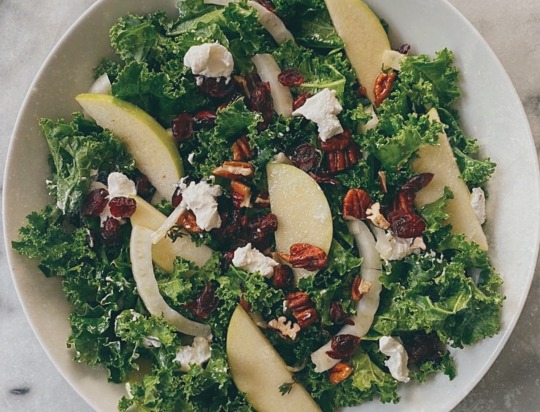
Pecan salad, typically with a sweet vinaigrette. It's very specific, but when M.M. was a broke SUNY student trying to stay healthy, he would fuck up a good chicken pecan salad from the nearby SuperFresh. You know how if you have too much of something, you get sick of it? M.M., a creature of habit, is not that type of guy. It's become a meme in the office to see how many times he comes in with a damn pecan salad (or a green chia smoothie, which almost won over the salad).
#headcanon request#the boys headcanons#annie january#billy butcher#frenchie the boys#hughie campbell#kimiko miyashiro#marvin t milk#mothers milk the boys#mm the boys
31 notes
·
View notes
Note
may i ask what’s your favorite jewish food item/recipe? i’m exploring various aspects of different jewish culture things because i want to convert and i know next to nothing about jewish foods beyond a few of the common ones, so i wanted to ask a few jumblrs about their favorites
Oooo,
My favorite food has to be matzoh ball soup, simply because matzoh balls are amazing.
My grandmas recipe is just a basic chicken soup recipe (carrots, onion, celery, leek, roast chicken from the supermarket) and then you add in the matzoh balls (shmatlz, a few eggs and some matzoh meal), and you just cook the balls in the soup.
I do not know any measurements as I was taught to do it by eye but I'm sure you'd be able to find a recipe online!
My second favorite recipe is this sweet raisin saffron rice! I have no clue how to make it as my Aunt has never given me her recipe but it's soooo good.
Bourkeas are also a fave of mine!
You just get puff Pastry, hard cheese (edam or tasty, Colby, etc, just hard cheese) and mix it with an egg, Feta, Riccota and add some pepper and put it on a whatever size of square you want and fold the Pastry into a triangle and then bake. Again it's all done by eye so I don't have exact measurements.
Malawah is also another fave food of mine but I don't have a recipe as my Grandma never told me her recipe. But I'm sure you could find one online.
21 notes
·
View notes
Text
4/23 tuesdaypost: slapdash
-1hp -1hp -1hp
listening: Rachmaninov album performed by David Helfgott. my specific recording is Very Special to me, it lives on my phone not my app and there's a section in one track where the CD skips because I ripped it to mp3s as a kid. also you can hear the pianist breath in sharply at certain spots and it just makes me feel some kind of way.
reading: started reading Leviathan Wakes! made a blood pact with a friend (I watched s1 of the show with him in like 2020 lol) to read it by the end of April and. checks calendar. lol. I'm only like a chapter or two in but I feel like I can power through it pretty fast so we'll see
watching: grian hermitcraft
playing: dndddd
making: working on quilting a dust cover for my switch! I made one a while ago just by sewing together rectangles and it Works but has zero structural integrity so I try again. this will be the top panel, done with quilt-as-you-go, it's a little sloppy and haphazard but I'm having fun using up scraps :)

painted some jellyfish on this plate but then noticed some chipping…and it flaked more ……. turns out there was a hunk of unmixed lime in the clay :") so the whole plate is fucked, it'll crack eventually anyways, so I went ahead and used it as a glaze test. will find out tmrw what it looks like!

knitting streamline tank pattern, frogged it and restarted because I realized I fucked up the ribbing in row 2 hahahah
eating: made that korean beef bowl thing again that I've linked before. yum!
for the last night of passover my roommate made an INSANE tasting menu that was passover themed. it ruled. 10 courses (for each plague), lots of little easter eggs (as in secret references to pesach lol), BONE MARROW, I died, it was so so so yummy.
the courses: sangria (glass of wine 1), greens with salty miso dip, amuse-bouche of eggs castellan, carrot four ways, tomato+wine soup (glass of wine 2), matzoh meal tart/mini seder plate (goat cheese, beets, greens, honey), bone marrow with greens and garlic butter, brisket and duck fat potato cube, matzohball soup dumplings, wine and pear sorbet (glass of wine 3), egg and wine custard (glass of wine 4)
pictured: carrot four ways (pureed, baked, pickled, air fryer crisped skins) (for the four children lol), matzohmeal tart, BONE MARROW!!!, brisket and cubed potato in duck fat (these were Insane), matzohball soup dumplings (weird and not great ngl but I appreciated the creativity)
pictured: carrot four ways (pureed, baked, pickled, air fryer crisped skins) (for the four children lol), matzohmeal tart, BONE MARROW!!!, brisket and cubed potato in duck fat (these were Insane), matzohball soup dumplings (weird and not great ngl but I appreciated the creativity)





3 notes
·
View notes
Text
Matzoh meal in the fridge, broth and veggies in the oven, 30min on the timer, and dinner should be ready to go in another hour at most.
There's no meat in the soup or broth, so maybe I'll float some wild rice in mine for protein, but the matzo balls themselves are fairly egg heavy (I used the leftover foyet sauce since it called for seasoned egg and oil anyway lol) so that should help them carry some protein as well as being very filling.
It feels right for matzo to be a go-to when I'm having this much trouble eating lol
2 notes
·
View notes
Text
Why Passover Is One of Judaism’s (of The Real Jews Not of The Zionist 🐷 🐖 🐗 🐖) Most Important Holidays
Passover, one of Judaism's most revered holidays, honors the ancient Israelites' freedom from slavery in Egypt.
— By Erin Blakemore | April 15, 2024
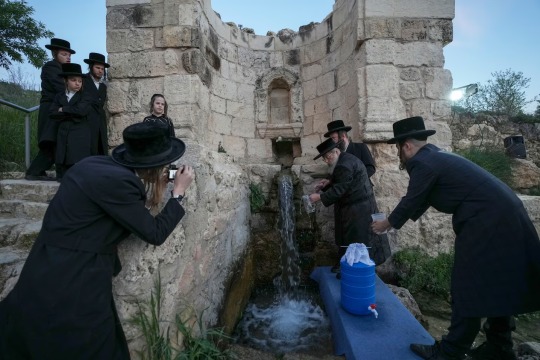
Rabbi Pinsk Karlin and other ultra-Orthodox Jews collect water from a spring to make matzoh, a traditional handmade unleavened bread for Passover, at a mountain spring in the outskirts of Jerusalem. Jews are forbidden to eat leavened foodstuffs during Passover. Photograph By Ariel Schalit, AP
As the days brighten and spring kicks into full swing, Jews all over the world prepare for Passover, a weeklong holiday that is one of Judaism’s most widely celebrated and most important observances. Also known by its Hebrew name Pesach, Passover combines millennia of religious traditions—and it’s about much more than matzoh and gefilte fish.
The Origins of Passover
The story of Passover can be found in the book of Exodus in the Hebrew Bible, which relates the enslavement of the Israelites and their subsequent escape from ancient Egypt.
Fearing that the Israelites will outnumber his people, the Egyptian Pharaoh enslaves them and orders every newly born Jewish son murdered. One son is Moses, whose birth has been foretold as the savior of the Israelites. He is saved and raised by the pharaoh’s daughter.
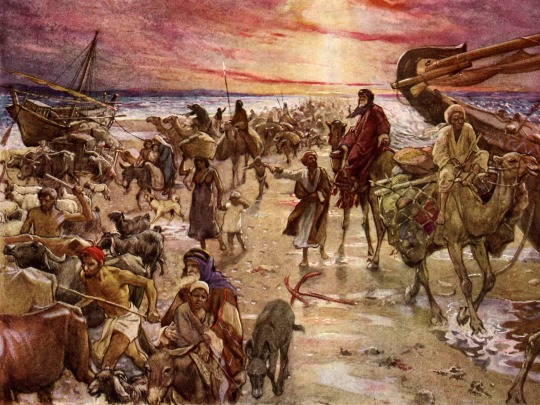
William Brassey Hole's "The Passage of the Red Sea" depicts the biblical story from Exodus in which God, acting through Moses, parts the Red Sea to allow the Israelites to cross to safety out of Egypt. Lebrecht History/Bridgeman Images
In adulthood, God speaks to Moses, urging him to tell Pharaoh to let his people go. But the pharaoh refuses. In return, God brings ten consecutive plagues down on Egypt (think: pestilence, swarms of locusts, and water turning to blood), but spares the Israelites.
During the final plague, an avenging angel goes door to door in Egypt, smiting every household’s firstborn son. God has other plans for the Israelites, instructing Moses to tell them to slaughter a lamb, then brush its blood on the sides and tops of their doorframes so that the avenging angel will “pass over.” Then they are to eat the sacrificial lamb with bitter herbs and unleavened—without yeast—bread. This is the last straw for Pharaoh, who frees the Israelites and banishes them from Egypt.
What’s on a Seder Plate
Modern Passover celebrations commemorate and even reenact many of the biblical events. The seder (“order”), the ritual meal that is the centerpiece of Passover celebrations, incorporates foods that represent elements of the story.
Bitter herbs (often lettuce and horseradish) stand for the bitterness of slavery. A roasted shank bone commemorates the sacrificial lamb. An egg has multiple interpretations: Some hold that it stands for new life, and others see it as standing for the Jewish people’s mourning over the struggles that awaited them in exile. Vegetables are dipped into saltwater representing the tears of the enslaved Israelites. Haroset, a sweet paste made of apples, wine, and walnuts or dried fruits, represents the mortar the enslaved Israelites used to build Egypt’s store cities.
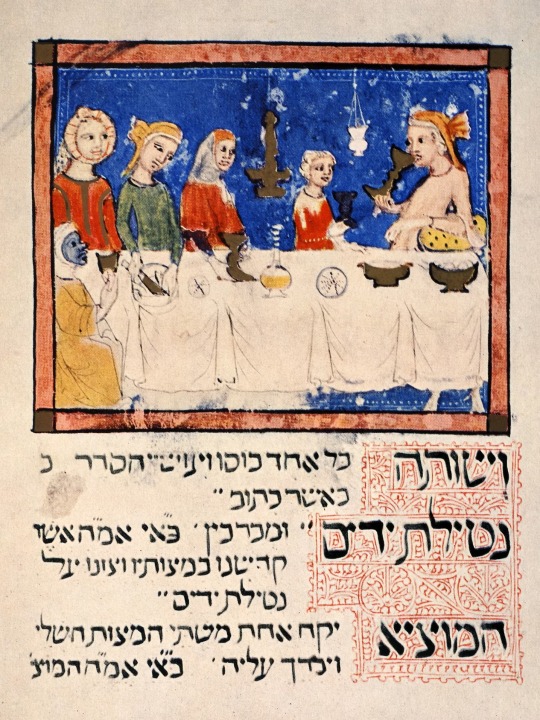
The centerpiece of modern Passover celebrations is the seder, a ritual meal commemorating the Israelites' escape from enslavement in Egypt. The dinner involves readings from a manuscript called the Haggadah. The Sarajevo Haggadah, pictured here, is one of the oldest, dating back to the 14th century. Photograph By Zev Radovan, Bridgeman Images
During a traditional seder, participants eat unleavened bread, or matzoh, three times, and drink wine four times. They read from a Haggadah, a guide to the rite, hear the story of Passover, and answer four questions about the purpose of their meal. Children get involved, too, and search for an afikomen, a piece of broken matzoh, that has been hidden in the home. Every seder is different, and is governed by community and family traditions.
How is Passover Celebrated
Passover observances vary in and outside of Israel. The holiday lasts one week in Israel and eight days in the rest of the world, in commemoration of the week in which the Israelites were pursued by the Egyptians as they went into exile.
During those days, many Jews refrain from eating leavened bread; some also abstain from work during the last two days of Passover and attend special services before and during Passover week. Orthodox and Conservative Jews outside of Israel participate in two seders; Reform Jews and those inside Israel only celebrate one.
But no matter where or how you observe Passover, its celebrations underscore powerful themes of strength, hope, and triumph over adversity and anti-Semitism.
A Brief History of Matzoh: 'It's Not Supposed To Taste Good'
Restrictions around matzoh are meaningful and refreshing to many: here’s why.
— By April Fulton | Published: May 17, 2023
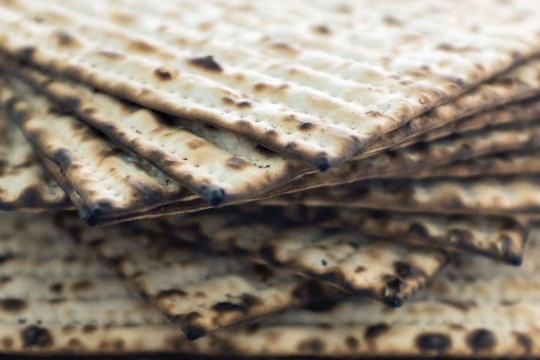
Matzoh is central to Passover, when Jews are prohibited from eating leavened food. Matzoh must be baked within around 18 minutes to prevent rising. Photograph By Becky Harlan, National Geographic Image Collection
Matzoh, known by Jews worldwide as “the bread of affliction,” is a cracker-like food made of flour and water eaten to commemorate the Hebrew slaves’ exodus from Egypt. The bland crisp takes the place of bread for the eight days of Passover.
While the aforementioned affliction may have changed over the years from one of desert-trekking deprivation to palatal hardship, most Hebrew scholars agree on one thing: It is not supposed to taste good.
Yet, for at least the first day of the holiday, many people actually crave it. Why?
For answers to this burning question about the nature of matzoh, we turn to Michael Wex, the author of Rhapsody in Schmaltz: Yiddish Food and Why We Can’t Stop Eating It.
“Now we eat it because we don’t have to eat it,” he says. In other words, because God’s chosen people have other choices the rest of the year, they look forward to eating matzoh to commemorate when Jews had no other choice but matzoh. And when it pops up in the grocery stores, many non-Jews pick up a few boxes, too.
According to the Hebrew bible, after a long protracted battle that featured God-directed plagues like frogs, boils, locusts, and the slaughter of first-born sons, the Egyptians freed the Hebrew slaves. The Jews left hastily, without time to let their bread rise. God basically tells them to take their dough and go, and that they’ll be cut off from Him if they eat anything leavened, i.e. yeasted or risen, for seven days. Hence—the first matzoh—the “roadside fast food from the ancient near East,” as Wex calls it.
The Passover seder dinner is centered around the matzoh, and is a virtual reenactment of the story of Exodus. In our family, the long, ritualistic dinner is frequently summed up for uninitiated guests in this way: “They tried to kill us, we’re still here, let’s eat.”
And so we eat matzoh, both plain and in forms that attempt to make it more palatable by adding salt and egg to create dumpling-like matzoh balls for chicken soup; or by topping it with sugary jam. Kids particularly love chocolate-covered matzoh for dessert.
Yes, there are other foods served at Passover, much of which varies according to where you’re from or what your grandma always made. Ours almost always includes brisket, kugel (a kind of casserole), and some kind of token vegetable. But matzoh is front and center.
There are strict specifications for making matzoh, of course. (Judaism is all about rules.) First of all, you only have 18 minutes from adding water to the flour to bake it. That’s the amount of time scholars say you have before the dough starts to rise, which would make the whole business un-kosher for Passover.
The result is a thin, flat plate-sized wafer “without even a kiss of salt,” Wex says. The first matzoh were probably round. The advent of machine-made matzoh led to the rise of the easier to pack and stack square marvel many of us know today. But the flavor? Pretty much the same, to my taste.
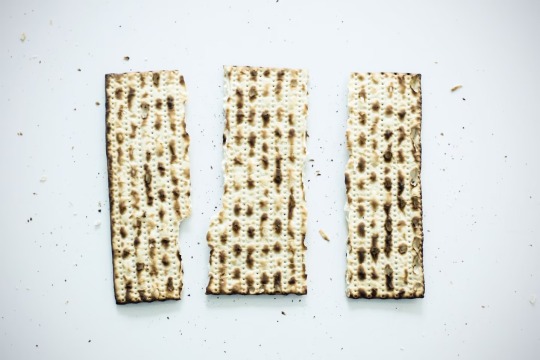
Traditional matzoh is broken ceremoniously at the beginning of the Jewish Passover seder.
There are also prescriptions for the matzoh to be harvested at a certain time of day and when it is dry enough, as prescribed by a rabbi, to prevent fermentation (i.e. leavening.) Dan Barber, back-to-the-land advocate and chef, made the case that the result of this close supervision may mean the wheat harvested is of higher quality, and therefore Jewish law may actually make food taste better.
But Wex and other scholars say this is beside the point. From Rhapsody in Schmaltz:
“There are those who say that God gave us cardboard so that we could describe the taste of matzoh, but taste is what matzoh is not about...Matzoh doesn’t need to be good, it only needs to be there—inside of 18 minutes. Or 22, according to some authorities; however long it took to walk to Tiberias from Migdal Nunia, the probable home of Mary Magdalene—a single Roman mile.”
Wex argues that the creation of Jewish dietary laws, particularly as they relate to matzoh, create for Jews a sense of otherness. While rules like no pork and no cheeseburgers may seem oppressive these days, in ancient times, it gave the Jewish people a new way of thinking. Once they were no longer slaves, they were “free to act in ways that have nothing to do with Egypt,” including, throwing out all their learned notions of what to eat.
There are entire Jewish communities, of course, who follow the ancient prescriptions to the letter for Passover and beyond. But do modern Jews still need to follow these ancient laws? Wex says you can have a strong Jewish conscience and not follow the dietary laws, but you should understand them “if you want your religion to stick around.”
The Very Ancient Passover of One of the Smallest Religions in the World
For thousands of years, the tiny Samaritan community has observed Passover according to its biblical laws.
— By Kristin Romey | Published: April 19, 2019
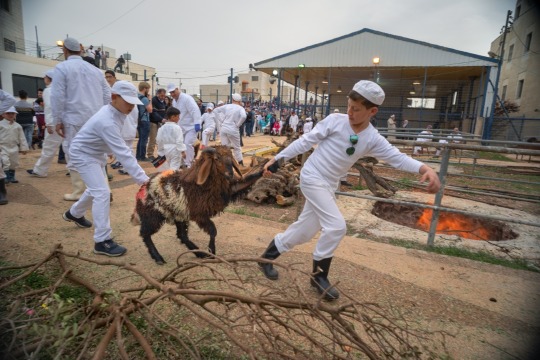
Samaritan boys wrangle a goat towards the sacrifice grounds on Passover eve in Kiryat Luza, West Bank. Photograph By Simon Norfolk
Samaritans are one of the world’s smallest religious groups, claiming descent from three of the 12 tribes of ancient Israel. They consider themselves the true observants of Israelite religion, and view Judaism as a religious practice corrupted during the Babylonian exile. This separation is clearly delineated in the geography of the Holy Land: While Mount Moriah in Jerusalem is where the Jewish Temple was decreed by God, the Samaritans followed the command of that same God and built their temple on the peak of Mount Gerizim, some 30 miles to the north.
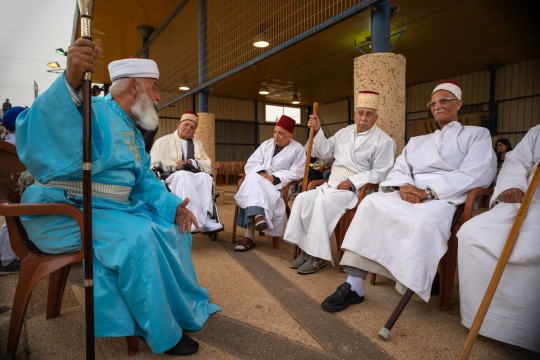
Samaritan elders gather during the Passover eve sacrifice. There are a little more than 800 people in the Samaritan community, almost evenly divided between the Tel Aviv suburb of Holon and the West Bank village of Kiryat Luza. Photograph By Simon Norfolk
Today, Mount Gerizim, at an elevation of almost 3,000 feet, is one of the highest points in the Palestinian territories, and commands a sweeping view of the bustling city of Nablus and the West Bank villages that surround it. On its ridge is the village of Kiryat Luza, where, on the eve of each Passover, the roughly 800 members of the Samaritan community gather to pray and observe their liberation from slavery in Egypt.
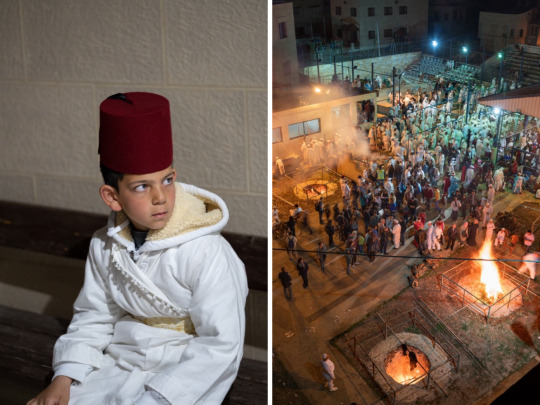
Left: A young Samaritan boy wears a distinctive red hat known as a tarbush. Right: worshipers and visitors mingle as the sacrificed goats roast for hours in large pit ovens. Photographs By Simon Norfolk
In remembrance of that event, the Samaritans follow the Torah mandate that a sheep or lamb be sacrificed on Passover eve and consumed before dawn of the next day. In Kiryat Luza, this is a communal event, in which prayers are recited and dozens of animals are dispatched simultaneously by men dressed in all white and then roasted in enormous earthen pits. In the hours after midnight, the meat is heaped on trays alongside bundles of bitter herbs and dished out in a celebratory community gathering under the stars.
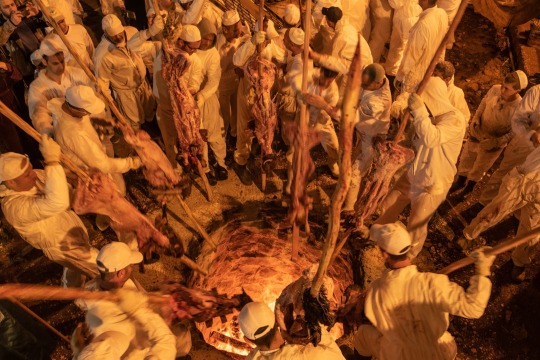
Following a group countdown, these Samaritan men will simultaneously plunge their skinned and dressed offerings into the blazing earthen oven. All of the meat must be eaten or burned before the sun rises on the first day of Passover. Photograph By Alessio Romenzi
Seven days later, the Samaritan community marks the end of Passover with a more solemn event. Once again under the stars just a few hours before dawn, the white-robed men of the community gather in front of their small synagogue, young sons beside them, rubbing the sleep from their eyes.
Led by their head priest cradling a silver Torah case, the men ascend Mount Gerizim in the darkness, climbing stone steps past the remains of their temple, destroyed by the Hasmoneans in the early second century B.C., and the rubble of a church built on their sacred peak by the Byzantine emperor Zeno some 600 years later. At points along the ascent, they stop to pray and then continue on as the dawn sky turns periwinkle and the paper-thin blossoms of scarlet poppies begin to unfurl.
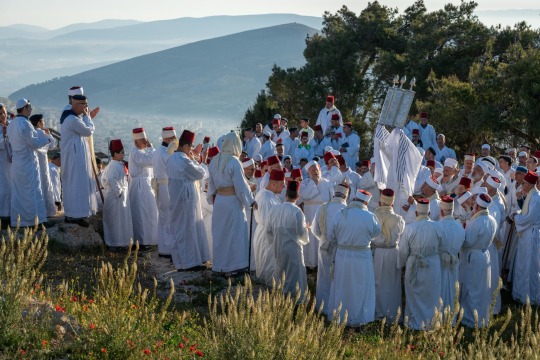
On the seventh day of Passover, white-robed Samaritan men climb to the peak of Mount Gerizim, where their ancient temple once stood. Photograph By Simon Norfolk
The procession ends near a stone slab believed by Samaritans to be the site where Abraham intended to sacrifice his son Isaac. The sun breaks above the horizon and the high priest raises the shining Torah case above his head as he concludes the group prayer. It’s a spring day on Mount Gerizim, and once again this tiny community has gathered together to fulfill its sacred duties before God.
#Judaism ✡️ | Holidays | Bible | Traditions | Diseases#History | Culture#Civilization#People#Water 💦#Ancient Egypt 🇪🇬#Religion#Baked Goods#Food 🍲🍱🥘
2 notes
·
View notes
Text
Aaron Jacob Levy (Introduction)
(still a work-in-progress)



details
full name: Aaron Jacob Levy
age: 38 years old
date of birth: February 16, 1986
place of birth: New York, New York
residential area: Downtown, Starlight Oaks, Washington State
gender: Cis-Male
pronouns: He/Him
sexuality: Bisexual
martial status: Single
occupation: Theatre Professor, Actor
faceclaim: Andrew Garfield
personality
personality type: ENFJ | the protagonist
moral alignment: chaotic good
astrology: Aquarius Sun, Taurus Moon, Cancer Rising
three positive traits: charming, quick-witted, kind
three negative traits: fickle, moody, neurotic
education: Bachelor of Fine Arts in Theatre, NYU | Masters in Fine Arts in Acting, Brown/Trinity REP
background
tw: death, grief, loss, cheating, cancer
It was a brilliantly sunny day when Aaron was born, which was not normal for February in New York City. Maybe it was a sign of things to come. The Lower East Side was his playground, and Aaron grew up living a happy life. His parents had been high school sweethearts growing up in Philadelphia, and they instilled in him, at a very young age, that love was indeed all you needed. Though they didn’t live in excess, his mother was a middle school choir teacher, and his father was a high school librarian; they had all that they needed. When he was five, they gave Aaron a baby sister, Talia, his best friend in the world.
It was many years of bliss—years filled with dirt-cheap movies, Hanukkah celebrations, record stores, and homemade matzoh ball soup. Years of discovering Shakespeare and pop music and discovering that maybe Aaron liked boys as much as he liked girls. Years of music, laughter, and joy filled the Levy household. Aaron wanted for nothing back then. He thinks back on this time in his life with bittersweet fondness, knowing he was lucky to grow up in a place that felt so warm.
When he was 18, he moved a few blocks north and attended NYU for his BFA in Theatre. He had found theatre in high school without much pushback from his parents. Yes, of course, it was a risky career path. But he had a spark, this big burning flare of talent and passion, and his parents didn’t want to snuff it out. Aaron had to work two jobs, alternating between working at a cinema and a bar, to afford anything, but he was happy, and that was enough.
It wasn’t until his senior year of college when his father got sick. Cancer caught him quickly and gave him little time. Aaron was devastated, trying to be home as much as he could. It was setting up for his Senior Showcase, but he didn’t have it in him to push through the pain and try as hard as he might have under better circumstances. He needed to be there for his mother and Talia. He spent much of the time that he was supposed to be in rehearsals, visiting his father in the hospital. It all went so fast, and suddenly, the wonderful Levys were now a family of three.
He managed to graduate, thankfully. Aaron was despondent, but he had maintained his grades and relatively good standing with the university, so he got out on time. He didn’t do particularly well in his Showcase, however, so he was not matched with an agent and manager like most of his classmates. It took him three years of hustling and grinding to make his way up on his own. Skimping on meals and working until he was numb and delirious. But it was also distracting, and carrying the grief he still held; he was grateful for any distractions.
And then, one fine day, right after his 25th birthday, Aaron was unbelievably lucky. Or at least, that’s what he says. He was in the elevator with the right casting agent, just making small talk, and landed an audition for Shakespeare in the Park’s summer production of A Winter’s Tale. He landed the part of Florizel, and from there, the parts just kept on coming. Over the next few years, he became a bona fide Broadway mainstay, hopping between contemporary and classical works effortlessly. He even had a brief stint as Fiyero in Wicked, which… scarred him for life. He would never do a musical again. He had bit roles in long-running New York City TV shows, like Law & Order SVU, and he felt calm. Like the hard work paid off, and he was making his dad proud.
It was early into these years that he met Travis Walker, a Broadway investor. Travis was older, not by a huge amount, but by enough. Over the years, Aaron had his fair share of flings; men and women were constant but fleeting, and he didn’t place too much stock into forming long-lasting relationships. He was married to his work, and though he was taught that love was so important, he found love in other things: his friends, and his plays and his drive to create art that mattered. But he met Travis on the opening night of one of his plays, and things moved quickly.
He fell, and he fell hard. Aaron was besotted. This was what he had been waiting for, at least he thought. It was perfect: every time he looked at Travis, he could swear he heard choirs singing like angels were in his ears. This was the love his parents had gone on and on about… it had to be. He felt infatuated and believed that he was adored in return. Travis would buy him trinkets and take him on lavish dates and make space for him in his penthouse on Fifth Avenue… this was the dream.
But soon, that dream was five years long. And Aaron was at the peak of his career, having just given a star turn as Hamlet. He thought he felt the proposal coming on… it had been years, and he had been so patient and attentive, even when Travis had his moods. Even when Travis started to travel much more. Even when things felt lonely. He was supposed to be at the theatre one night for a post-show celebration, but he decided to head out early for the evening, wanting to spend the evening with his partner. When he got home, he discovered a waking nightmare: Travis and a chorus boy. He methodically packed up, absolutely crushed by Travis’ cold and cruel nonchalance at what had transpired. He didn’t even care that it was ending… and then it was done.
Aaron needed to leave the city… he needed to get out. He moved most of his things, which weren’t too much, into a storage unit, grabbed a large backpack, and left. Took a flight to Europe and backpacked. Spent some time roaming around Asia. Came back to the States and got off and on Greyhound buses until he was fully wiped. It was almost two years of this. He needed to shake it out of his system and get the grief and the loss out of him. It was then, at age 32, that he decided he would go back and get his Masters.
Getting into Brown’s program was easy. He was a celebrated actor and though the shock of him being in class with his cohort was a bit much, at first, he settled in nicely. He fell in love with Rhode Island, and 3 years on the coast did him well. He learned so much about himself and what he wanted to do, and what he needed in his life, and he wouldn’t have traded that time for the whole world. When he got out, he was still disillusioned with New York, so he looked for jobs elsewhere.
That’s how he landed on Starlight Oaks. He’d had a friend in his cohort who had spent some time in the area, and when he saw an open job at the University, his friend recommended it. It was another coastal city, welcoming and waiting for him. He couldn’t wait to see what was in store.
4 notes
·
View notes
Text
i love pesach but holy shit am i glad i can eat chametz again
#pesach is the college student killer#jumblr#pesach#the amount of matzoh i have eaten would kill a lesser man#but i actually figured out how to make meals from it this year#last pesach was. we don’t speak of it or the culinary disasters
20 notes
·
View notes
Text
Custom soup Packaging: Elevating Tradition with Modern Boxes
Custom soup Packaging: The Impact of Custom Matzoh Ball Packaging Design In the ever-evolving food landscape, the demand for innovative and easy meal solutions has led to an interesting intersection of culture and convenience. From instant ramen to quickly prepared pho, the instant soup segment is burgeoning with options to suit every taste. Yet, one product is stepping into this competitive…
0 notes
Text
Karyn's Cranberry Crisp- Thanksgiving
Fully Cooked Cranberry Crisp This recipe has been around pretty much my whole married life. If there is a turkey on the table, there is cranberry crisp next to it. It originated from my bestie Karyn. We make it for Passover with matzoh farfel since we love it so much. It’s so sweet and delicious that it could really be a dessert. We love it with our meal; love the sweet and savory thing. You…
#Cranberry Apple Crisp#Cranbery Crisp#Karyn&039;s Cranberry Crisp -Thanksgiving#Karyn&039;s Crisp#Thanksgiving Cranberry Crisp
0 notes